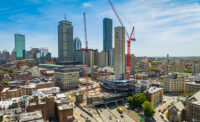After decades of planning and false starts, a 51-story tower is finally taking shape over Boston’s South Station, set to be one of the city's tallest buildings.
The tower’s steel frame recently passed the 109-ft mark on its way to an eventual 680 ft, rising above the 604-ft, 33-story Federal Reserve building across Summer Street. At 60-stories and 790 feet, 200 Clarendon, better known as the John Hancock Tower, is Boston's tallest building.
Texas-based developer Hines held a groundbreaking ceremony for the $1.5-billion South Station tower earlier this fall, delayed from early 2020 due to COVID-19 restrictions. Set to open by the second quarter of 2025, the 1 million-sq-ft tower includes 166 luxury condos, 670,000 sq ft of office space and 500 parking spaces. Residential units will feature floor to ceiling windows, while the Ritz-Carlton brand will help oversee units and related building amenities, the developer says.
Hines also plans a second building over the tracks at South Station, estimated around 300 ft tall, for which it says it has secured needed approvals. The developer has not disclosed if it will be commercial or residential.
“The market has changed a bit with the uncertainty around getting people back into the office,” said David Perry, Hines senior managing director in charge of New England.
Decades in The Making
Plans for a tower atop the train station date to the 1980s, with Hines having been in charge of its project for the past two decades.
Previous efforts to move it into construction faced impacts of the Great Recession, and regulatory issues that included concerns raised by the Federal Aviation Administration that led to a significant reduction in height. There were also complicated discussions with the Massachusetts Bay Transportation Authority to work out the logistics of erecting a skyscraper over an active rail and bus hub.
The project was set to go in late 2019, with Hines obtaining needed financing. The project's Chinese investor sold its stake to APG, which oversees $570 billion in Dutch pension funds.
But the pandemic in early 2020 triggered another delay, with the city’s construction shutdown before work could resume.
Down to Work
Work over the past two years has focused on a 100,000-sq-ft expansion of the bus terminal at South Station, which the developer was required to manage, under its agreements with state officials, before building the tower.
The steel is topped out for the expanded bus terminal and a garage being built above it, with concrete decks now being poured. The expanded terminal, which will connect with South Station, is taking shape on foundations that were installed between the tracks back in the 1980s.
Initially, work had to be done at night to keep rail passengers safe, but as the project has moved forward, construction has shifted into the daytime.
The logistics were challenging given different city, state, and federal agencies that needed to be consulted, as well as the challenge of building amid the hustle and bustle of a busy commuter rail station, said Jeff Gouveia, northeast president and general manager for the project’s general contractor, Suffolk Construction.
“Train schedules are not flexible,” he said. “As they say, it takes a village of intense coordination to pull something like that off.”
The expansion will boost bus terminal capacity by half, while related public improvements at the train station will expand the outdoor concourse by two-thirds and shelter it from the elements.
Passengers will be able to move seamlessly between the commuter rail, bus terminal and Red Line rail below the station.
The tower itself required a separate and more substantial foundation than was originally planned, with early sketches for developing air-rights over South Station never envisioning a structure of its size.
Work on the deep foundation began in November 2021 and completed in February. Work started in March on cape beam foundations—and vertical construction, Gouveia said.
S&F Concrete, McDonald Electric and Banker Steel are Suffolk’s main subcontractors.
Taking Shape
With the tower itself starting to take shape, some major ancillary truss pieces were recently set into place and steel erection is set to begin in late January. Up to five trucks per day are delivering steel to the site, while 10 to15 trucks are pouring concrete, Gouveia said.
Suffolk used a logistics software program to coordinate all deliveries, requiring drivers to apply for a time slot. Only a few Suffolk team members had access to the scheduling software, with deliveries turned away if they had no slot.
“Every one of the deliveries is electronically tracked,” Gouveia said.
There are now 250 workers on the site, with that number ramping up to 1,000 in the second half of next year and into 2024, according to Hines’ Perry.
He says project shutdown during pandemic early stages initially pushed back its timetable by several months, but the construction team has been working steadily to catch up.
“We are making up the schedule where we can, although there is a limit to what you can do there,” Perry said.





